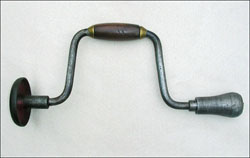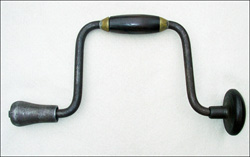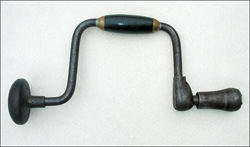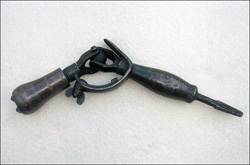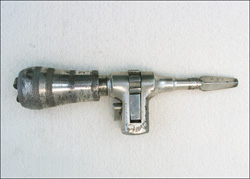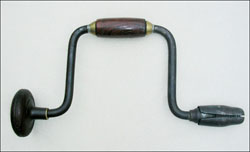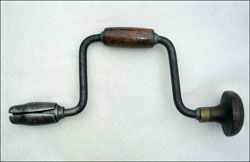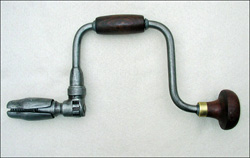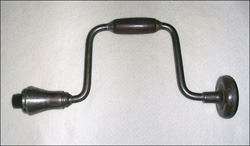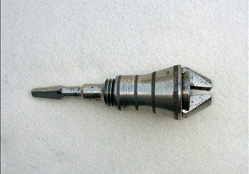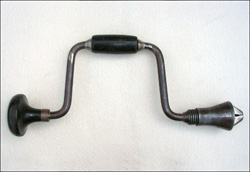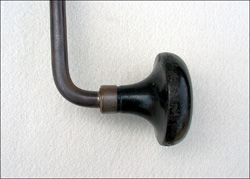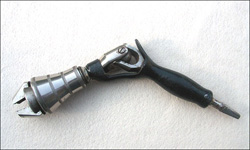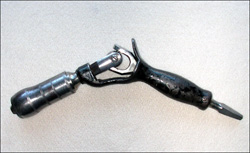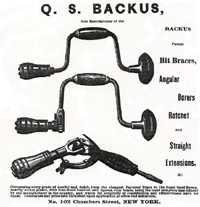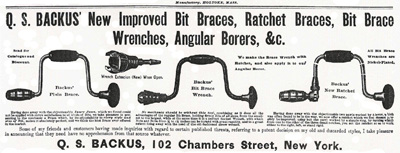Quimby S. Backus Bit Brace Gallery
The asterisks seen below the picture of a brace are an indicator of relative rarity. One asterisk indicates a brace that is commonly seen; five indicate a rare item.
1872 Backus chuck
On November 5, 1872 Quimby S. Backus was issued United States Letters Patent No. 132,791 for a bit brace. The patent covered both the brace's sweep handle and its chuck. Backus manufactured a variety of braces and attachments that featured his chuck design; the handle design was used only on his firm's premium braces.
Backus version of Draper chuck
Sometime prior to 1880, Quimby Backus acquired the rights to a chuck that had been patented by William W. Draper on July 11, 1865 (Patent No. 48,763). Backus reworked the design and came up with a brace that bore little resemblance to that depicted in Draper's original patent drawings. The Backus redesign features a bizarre-looking chuck that consists of two massively oversized jaws pinned to a nut that travels up and down the threads of its socket. As the nut travels up the socket, the rear edges of the jaws encounter a cone that spread them apart. Since the jaws pivot at mid-point, their front parts move inward, closing over the shoulders of a square-tang bit.
1879 Backus brace wrench
In 1879, Quimby Backus patented a brace wrench (Patent No. 216,776) that was capable of turning nuts from 1/4 inch in size to 1 1/4 inches. The drawings accompanying the published patent illustrate both non-ratcheting and ratcheting versions of the tool. The ratchet depicted is an exposed pawl, lever-adjustment model. The premium-grade ratcheting brace wrench seen below features the later ring adjuster and concealed pawl ratchet that Backus patented in 1881 (Patent No. 250,047). The Q. S. Backus Company also manufactured an adapter for converting a standard bit brace into a wrench. The adapter was available in a ratcheting model with a lever adjustment and a non-ratcheting version.
Backus 1880 chuck
In December 1879, Backus lost the right to manufacture the chuck he had patented in 1872. He responded to the situation by selling braces equipped with his Draper-type chuck while he worked on developing and patenting a new design. A new chuck, based on two different patents, was brought to the market in late 1880. The chuck featured a chuck with two opposing grooves cut into the exterior of its threaded socket. Within each groove, a strap-type spring engaged a notch in the rear of the jaw. As the shell was loosened on the threaded socket, pressure from the springs forced the jaws apart. The self-opening chuck, stamped with October 19th and November 16th patent dates, became the operation's new standard (Patent Nos. 233,464 and 234,517).
Advertisements
Thanks to Brian Welch for sending these ca. 1880 advertisements from the magazine Iron Age. In late 1879 and early 1880, Backus was hit with a pair of patent infringement suits that forced a re-design of his bit braces. In the second ad, Backus makes reference to the lawsuits and to his previous designs as "old and discarded styles." More information on the Quimby Backus and his legal problems can be found on the Quimby S. Backus page.
